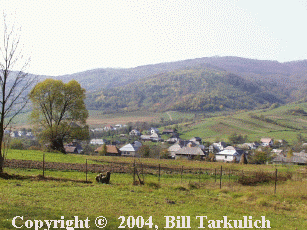
Zboj has been the village of my TARKULIC’ family for more than 200 years.
It
was called "Harczos" in Magyar (Hungarian) prior to 1918.
Zboj is a small farming village in the foothills of the Carpathian Mountains. Its citizens are primarily of Rusyn (Ruthenian) ethnicity and the majority have lived in their village their entire lives. They are poor by western standards, but have everything they need. The town has one major thoroughfare(1) with 3 or 4 minor spurs, each containing little more than 10 houses each. It has a grocery(1), small tavern, elementary school and a town hall. The village is about 20 kilometers to the nearest train station in Stakcin, keeping it fairly isolated from the world. Zboj is situated in the valley, with the Zboj Creek(1) flowing through and cultivated hillsides(1) on both sides. The region was electrified in the 1950, but old ways such as water wells and outhouses remain in use.
The original Greek Catholic Church was removed to a Skanzen and replaced in the 1960's with an Orthodox structure. [All Greek Catholic churches were closed in 1947 by the Communist government, their priests deported, with some structures handed over to the Orthodox church.] We met Father Ladislav, 2 years since his assignment here. He is in his mid-20's of age.
The population is about 500 people, with about 200 homes evident. Most of it's citizens are elderly. The people(1) are strong and hard working. Most people begin working at 5:00am. It is a compact village, on a road(1) which “dead ends” one village to the North, about 3 KM to Nova Sedlica. Most people in this village appear to be over 40, as the young have generally migrated to larger Slovak Republic cities for employment. Until collectivization in 1947 Zboj land and forests were owned by a land Baron, who controlled this vast region.
The word “Zboj” means “bandit”
though it's nearly impossible to ascertain reason for the name choice. There is one collective farm operation just south of the Zboj village, on the east side of the road. Otherwise, the land is residential. Homes are clustered on an approximately 1/4 acre lots(1). Their plots of land primarily contain their gardens. No lawns or lawnmowers here. There are several abandoned homes to be found here.
Contemporary homes (most are at least 40 years old) are quite similar in form to the traditional houses of 100 years ago. Homes are traditionally made of whitewashed clay bricks. Their roofs are wood framed, with
asphalt shingles and wooden floors being their only concession to modern construction techniques (grass-thatched roofs and earthen floors were previously used). Those who can afford to use tin as a roofing material. The lower level is similar to a walk-in basement in America. It has an earthen floor and is used for storage and summer cooking and sleeping (when it gets too hot). Earthen floors in this region are
surprisingly solid. The earth does not move around, and after some amount of use, is a smooth, hard and broom-sweep-able surface. The main entrance is about 8 steps upward to the single-level homes consisting of 3 or 4 rooms (approximately 10'x10').